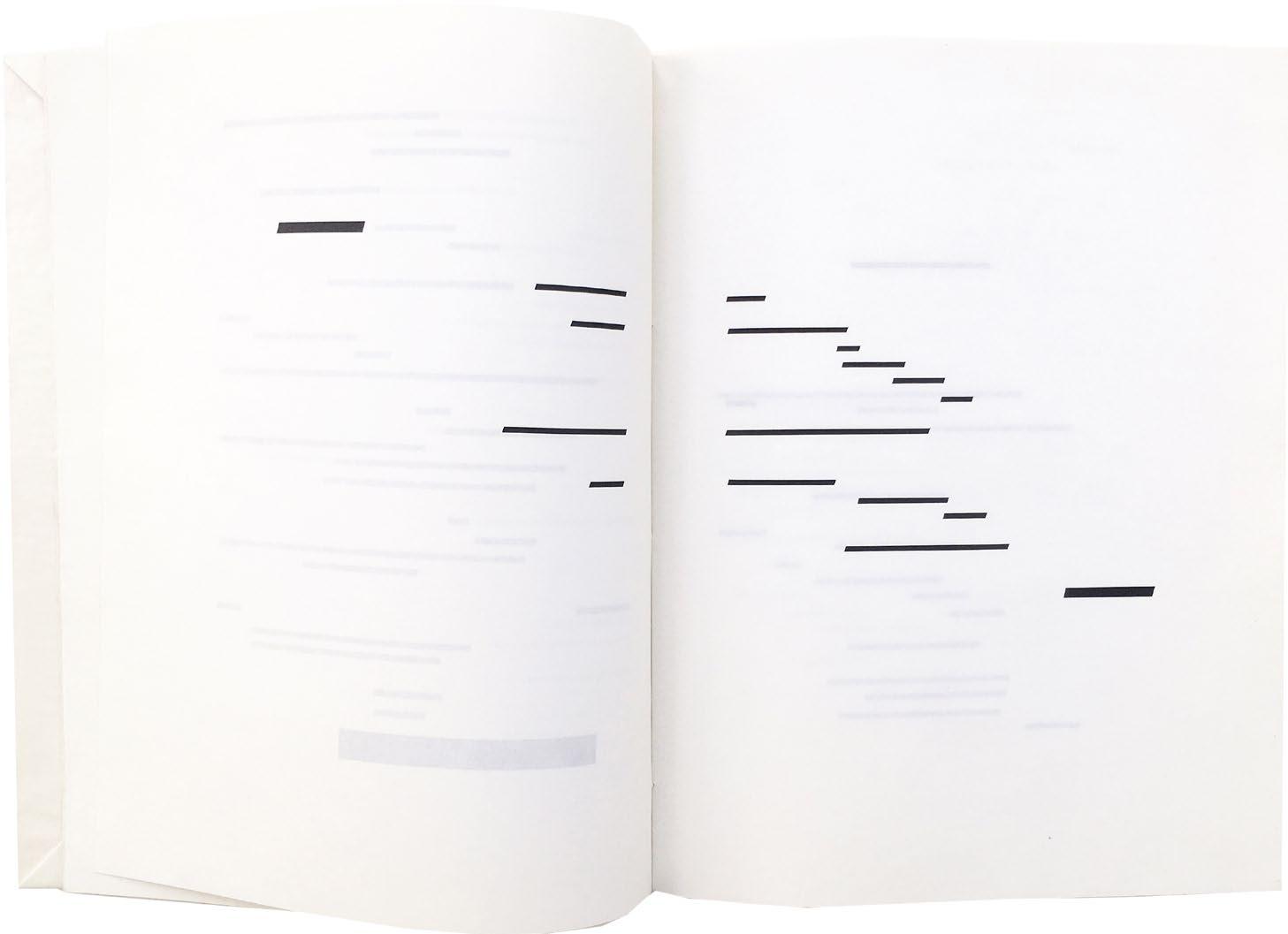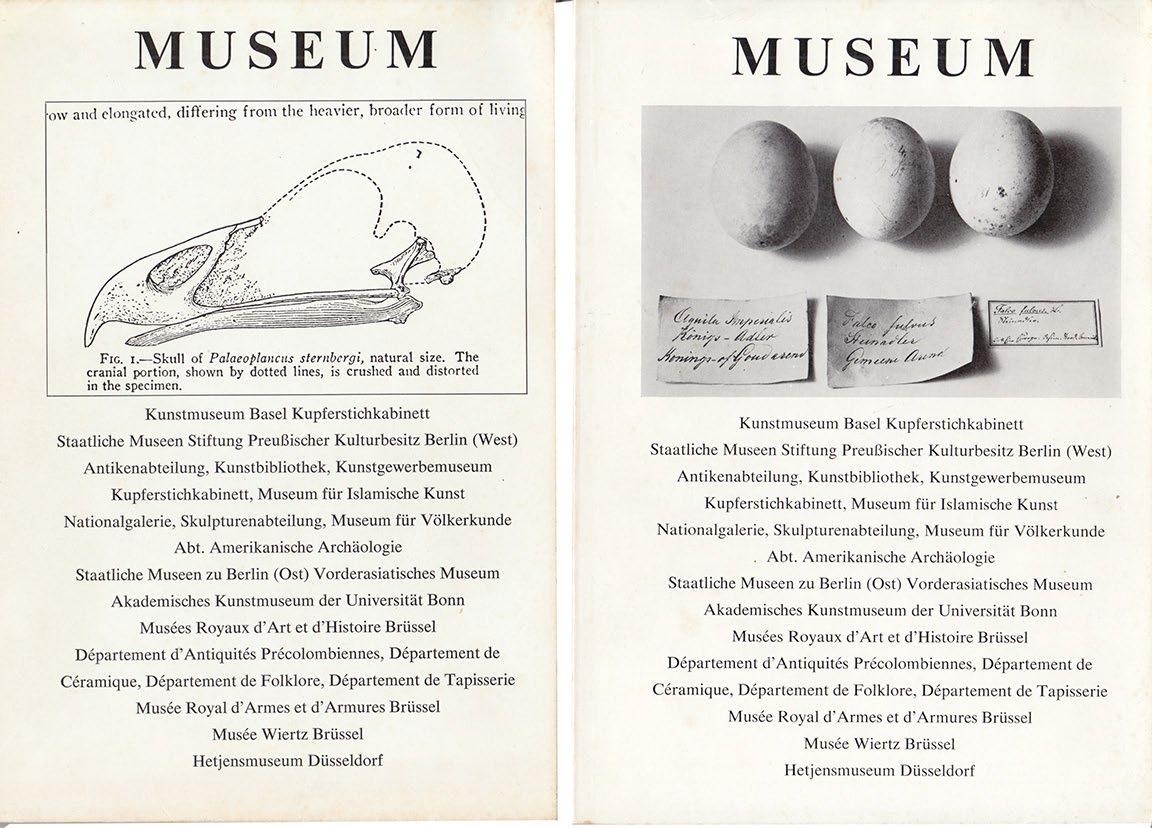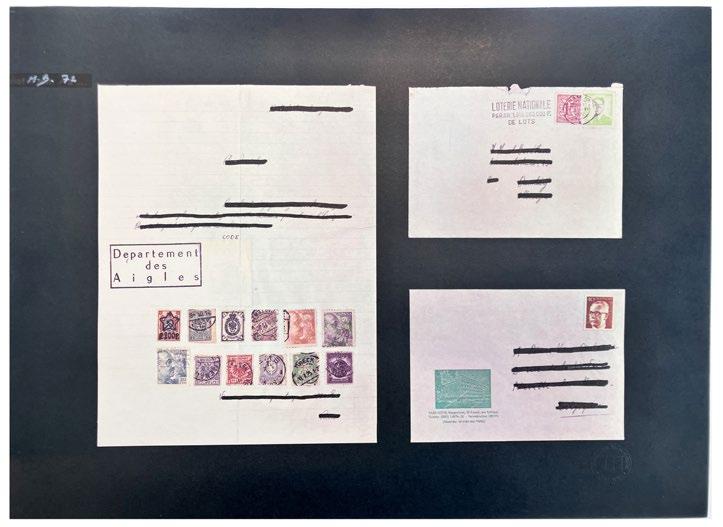
8 minute read
—
Antwerp
Wide White Space Gallery
1966
Moules / Oeufs / Frites / Pots / Charbon
8vo. (200 x 138 mm). [3 bifolia including wrappers]. Title and exhibition details to front wrapper with brief artistic biography of Broodthaers' verso, blank leaf, leaf with reproduction of Broodthaers' manuscript recto and 'Ma Rhetorique (Moule)' verso, leaf with 'Poème (Oeuf)' recto and 'Théorèmes (Frites)' verso, blank leaf, inner rear wrapper with publication history and texts on Broodthaer's work and rear wrapper with advertisement for the gallery; illustrated with reproduction of Broodthaers' manuscript and three monochrome illustrations. Original publisher's white stapled printed wrappers with titles and text in black.
Held at Antwerp's Wide White Space Gallery from 26th May - 26th June, 1966 (with the vernissage held on 26th May), Marcel Broodthaers' exhibition 'Moules Oeufs Frites Pots Charbon' was a typically poetic artistic exercise and the catalogue presented here, for the same exhibition, is no different. Although the catalogue incorporates standard biographical texts and timelines - it includes texts by Jean Deypreau ('A Fleur de Pot') and Pierre Restany ('Quand la Vie Devient Objet') - it works also as an artist book, featuring a reproduction of Broodthaer's repetitive inscription of several of the words of the title - he omits 'charbon' but includes 'coeur' - and three of his illustrated poem works: 'Ma Rhétorique (Moule)', 'Poème (Oeuf)' and 'Théorèmes (Frites)'. Each of these poem works is typically playful and typically gnomic incorporating absurdist repetitive text, word substitution, satirical aphorism and counterintuitive illustration.
'La pipe de Magritte est le moule de la fumée.' (From Broodthaers' text).
The catalogue is scarce and OCLC locates copies at the National Gallery of Art, Washington, the Bibliothèque Kandinsky, Paris, the Kunstbibliothek of the Staatliche Museen, Berlin and the Vlaamse Erfgoedbibliotheek only; COPAC locates only a copy of the 1974 reprint in the UK.
£1,250
Un Coup de Dés Jamais N’Abolira le Hasard - Image Antwerp / Cologne
Wide White Space Gallery / Galerie Michael Werner 1969
Folio. (326 x 250 mm). [16 unnumbered leaves, blanks included]. Leaf with Broodthaers' title, leaf with 'Préface' signed by Stéphane Mallarmé (a transcription in toto of Mallarmé's original verse replacing Mallarmé's original prefatory text), blank leaf, leaf with title cancelled with black line and 10 leaves with Mallarmé's verse with each line cancelled in black, final verso with 'Imprimé en Belgique' and final leaf with justification and copyright recto. Original publisher's white printed wrappers with titles in red and black to front cover within rules of black and red, printed 'exemplaire catalogue' to rear cover, original glassine dust-jacket as issued.
From the edition limited to 400 copies, with this one of 300 marked 'exemplaire catalogue' on white wove paper without watermark, inscribed by Broodthaers in blue ink, signed with his initials 'M. B.' (as usual) and dated 'déc. 69.'; the copies marked 'exemplaire catalogue' were not issued with a signature or number.
Broodthaers' inscription replaces his own name (he has crossed through it with a large 'X') in 'Copyright 1969 by Marcel Broodthaers Bruxelles' with an arrow from the 'by' to the new names 'Olga et Sandro', while beneath he has dated and signed it: 'déc. 69. / M. B.'
Olga Morano (1935 - 1999) was a Paris-based conceptual artist, painter and sculptor. A close friend of Broodthaers and other Belgian artists such as Marcel Mariën, she owned a number of artist books by Broodthaers that included presentations. The present book, Broodthaers' appropriation of Mallarmé, with its presentation to 'Olga et Sandro' becomes Broodthaers' gift of his appropriation of Mallarmé: i.e. the appropriation of Mallarmé by 'Olga et Sandro', a further irony in the conceptual labyrinth of mirror images the book presents and represents.
'It seemed to me that I was looking at the form and pattern of a thought, placed for the first time in finite space. Here space itself truly spoke, dreamed, and gave birth to temporal forms.' (Paul Valéry on Mallarmé's 'Un Coup de Dés Jamais N'Abolira le Hasard: Poème').
In 1914, Stéphane Mallarmé’s ambitious typographical construction, the extraordinary poem, 'Un Coup de Dés Jamais N’Abolira le Hasard: Poème', was finally published - in the form that Mallarmé had himself envisaged - by Gallimard's 'Editions de la Nouvelle Revue Française'. A version had appeared during Mallarmé's lifetime, in 1897, in 'La Revue Cosmopolis' but the title aside, Mallarmé's vision for the poem - refused by printers at the time as unfeasible and absurd - was ignored. The original edition of 1914, seen through the press by Mallarmé's son-in-law, was printed as a limited edition in Belgium in 1,000 copies, 100 large paper examples and 900 ordinary copies (the ordinary copies unmentioned on the justification). The poem itself is a typographical caprice and a visual object of linguistic power that preceded Apollinaire's calligrammes by more than a decade. In Mallarmé's own words, taken from his introductory 'Préface': 'les «blancs» en effet, assument l’importance, frappent d’abord ; la versification ... occupe, au milieu, le tiers environ du feuillet … '.
In 1969, Marcel Broodthaers took Mallarmé’s assertion at face value, and presented his own version of the poem. The covers in Broodthaers' artist book replicate almost exactly those of the 1914 edition albeit with three specific modifications: the replacement of Mallarmé's name with that of Broodthaers, Mallarmé's 'Poème' has become Broodthaers' 'Image', and the location and name of the original publisher has been replaced with those of the later edition, Brussels and Cologne in place of Paris, and Wide White Space and Galerie Michael Werner in place of Gallimard's 'N R F' (Nouvelle Revue Française).

Further, Broodthaers replaced the title (it reflects the changes to the cover), the 'Préface' in Broodthaers' version is the whole text of Mallarmé's original poem (Mallarmé's own 'Préface' has been removed), the justification mirrors that of the 1914 edition (including the omission of the details of the 'édition courant' of 900 copies as is usual with a French publication) and, of most importance, Broodthaers has redacted Mallarmé's poem throughout with a series of black effacements that exactly match the typographical arrangement of the original. Broodthaers’ process transforms Mallarmé’s 'Poème' into 'Image', from poetry to graphic, into a pure abstraction, a book without text.
'After a two-decade 'obsession' with Stéphane Mallarmé's seminal modernist poem of the same title, to which fellow Belgian René Magritte had introduced him, Broodthaers finally decided it was time to 'redo the roll of the dice'. Using the 1914 Gallimard edition of Mallarmé's 1897 work, he covered over his fellow poet's words - so carefully arranged on the page... '. (Artist Who Make Books).
[Ceuleers 33; Jamar 32; Werner 8; Artists Who Make Books, pp. 50 - 51].
£12,500

Düsseldorf
Alfried Holle for Städtische
Kunsthalle Düsseldorf
1972
8vo. 2 vols. (210 x 148 mm). pp. 64; 64. Title, monochrome frontispiece and list of contents to each vol., printed text in German and monchrome and colour illustration throughout. Original publisher's white printed glossy wrappers with text and illustration in black.
Museum. Der Adler vom Oligozän bis heute. Zeigt eine experimentelle Ausstellung seines Musée d'Art Moderne, Département des Aigles, Section des Figures
Broodthaers' exhibition was held in the Städtische Kunsthalle Düsseldorf from 16th May - 9th July, 1972. Designed by the artist himself, the extensive catalogue contains entries and statements by the artist, together with a detailed catalogue of works, an encyclopedia (A - M in vol. I, M - Z in vol. II), bibliography and extensive illustration; unsurprisingly given Broodthaers' title, 'Der Adler vom Oligozän bis heute' (The eagle from the Oligocene [era] to today) the images are dominated by that of the eagle. The Oligocene was a geological epoch beginning approximately 34 million years ago although the eagle as a genus ('aquila') appears to have evolved in a later era, the Miocene.
£300

[05]. — Broodthaers’ ‘Lettre Ouverte’ print depicting the envelopes and letter for a ‘Lettre Ouverte’ with cancelled text.
Folio. (380 x 515 mm). Sheet of thick wove paper with colour offset print by Marcel Broodthaers recto only, initialled and dated in white crayon at upper left and with the publisher's blindstamp at lower right.
Lettre Ouverte. (Version Définitive)
From the edition limited to 300 unnumbered copies initialled 'M. B.' and dated '72' in white crayon at upper left and with the blindstamp of the publisher with the text 'RIJKSCENTRUM FRANS MASEREEL KASTERLEE' at lower right; a proof version was also issued.

Marcel Broodthaers composed a series of what he termed 'Lettres Ouvertes' (open letters) issued from his 'Departement des Aigles' which he then sent to members of the art-world. Many of the letters were published subsequently in small editions as printed texts, or, as here, had the text cancelled and made into an original image. The letters often comment on the social context of art of the period or allude to the weather, flowers, gardens and more ephemeral and traditionally Romantic themes. The ironical and ambiguous use of a confidential tone, the power of Broodthaer's one-man movement, the use of an 'old-fashioned' instrument such as an open letter in a world so fond of 'new media', are all typical of Broodthaers' critical interventions in the often self-involved and self-conscious world of art.
The proof version of this 'Lettre Ouverte' features uncancelled text and shows that the envelope at upper right features Broodthaers' own address, while that at lower right is addressed to Pierre Van Osselaere. The actual letter, dated 'le 6 Juin 1972' and addressed to 'Cher Masereel' reads as follows: 'Le ciel est dégagé ce jour ... les nuages / sont devenus plus rares et je vois des oiseaux poindre à l'horizon ... / il n'est peut-être qu'un cauchemar. / Vivions-nous un printemps en 1972?'
[Ceuleers 13a]. £4,000
(Brussels)
1972
presentation from the artist.
Small 8vo. (152 x 108 mm). Magic slate of pale green card with metal reinforcement to edges, window cut to front with celluloid panel showing the magic slate, ink inscription verso. Loose as issued in original (?) envelope, later card protective box.
L'Ardoise Magique ou la Signature de l'Artiste
The pale green card backing of the slate is inscribed by Marcel Broodthaers in a darker green ink: '"L' Ardoise Magique, / ou / "La Signature de L'Artiste, / 30 Octobre 72 / A. Françoise Lambert, / MB.'
The artist's widow, Maria Gilissen, has stated that Broodthaers' created some 18 different 'magic slates' in various sizes, combinations and formats, however very few examples were inscribed and presented by him. This example features Broodthaers' signature, his initials, multiple times to the re-usable surface as well as to the verso of the card enclosure where the work is titled, dated and presented. Françoise Lambert, to whom the work was presented, was the owner of the eponymous Galleria Françoise Lambert in Milan, where Broodthaers (and others of the so-called 'neo-avant-garde' such as Buren) held a number of exhibitions.
Sigmund Freud thought the magic slate or writing slate (in French 'ardoise magique' or 'Wunderblock' in German) analogous to the human system of perception and its links to the unconscious - his 1924 essay 'Notiz über den 'Wunderblock'' outlines his theory - and it seems likely that Broodthaers, like Freud, was intrigued by the magic slate's capacity to retain detail even if that detail has been erased by the action of the slate's 'magic' and is no longer visible.
'L'ardoise magique repose sur le principe suivant : toute inscription est effacée simplement en tirant sur la plaquette médiane. Elle reste cependant gravée, invisible, sur une pellicule à l'intérieur de l'appareil. / Die Schreibtafel beruht auf dem folgenden Prinzip : jede Beschriftung wird durch einfachen Herauszichen der Tafel ausgelöscht. Sie bleibe über unsichtbar auf einen Film in Innern der Vorrichtung graviert. / The writing slate is based on the following principle : each inscription can be wiped off just by pulling out the plate. Yet it remains invisibly engraved on a film inside the device.' (From Marcel Broodthaers' 'Magie').
' ... this is precisely the way in which, according to the hypothesis I mentioned just now, our mental apparatus performs its perceptual function. The layer which receives the stimuli - the Pcpt.-Cs. [Perception-Consciousness] - forms no permanent traces; the foundations of memory come about in other, adjoining, systems ... I do not think it is too far-fetched to compare the celluloid and waxed paper cover with the system 'Pcpt.-Cs.' and its protective shield, the wax slab with the unconscious behind them, and the appearance and disappearance of the writing with the flickering-up and passing-away of consciousness in the process of perception.' (Sigmund Freud translated by James Strachey).
£17,500



![[10]. —Artist book of poetic fragments by](https://assets.isu.pub/document-structure/230714121650-25f491982fb1daea39e902bffb6160bb/v1/887944ce4c3bd90c1afd7edf415d2f8e.jpeg)

